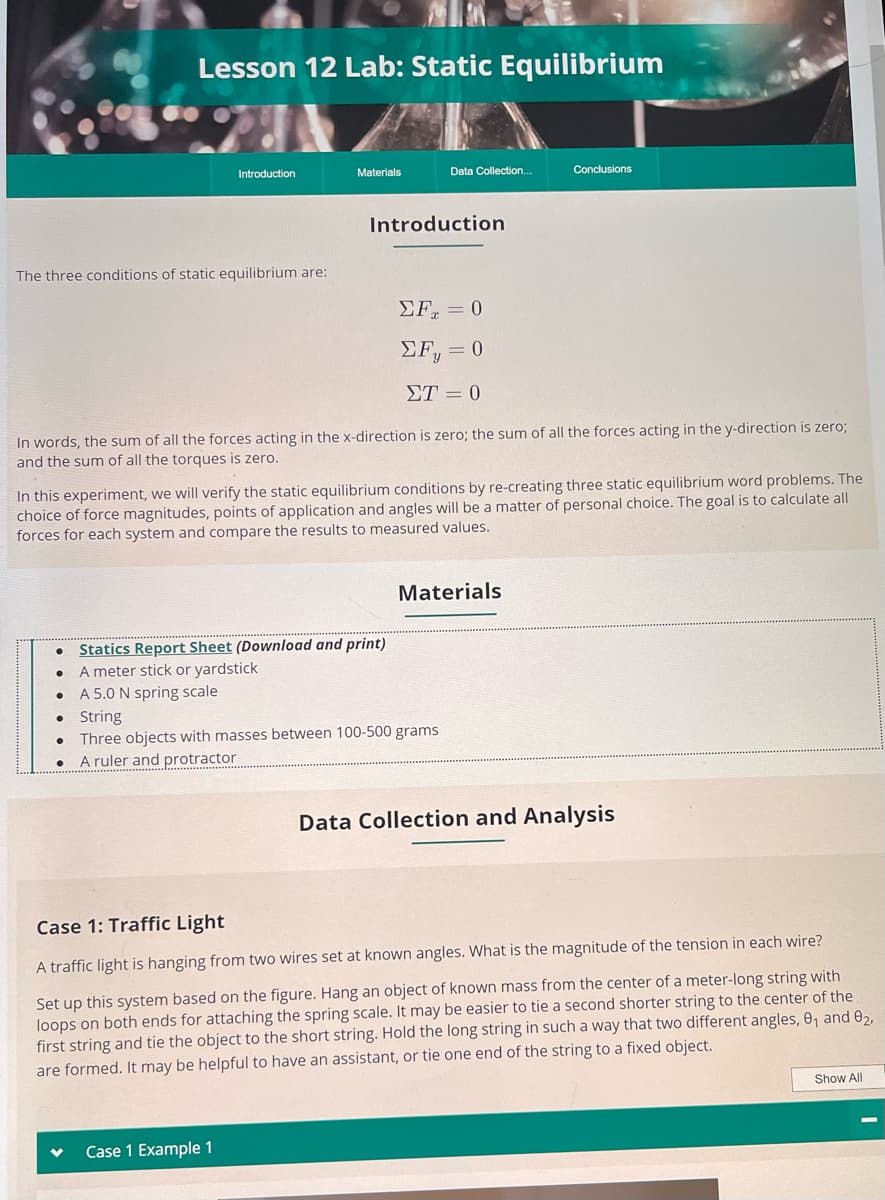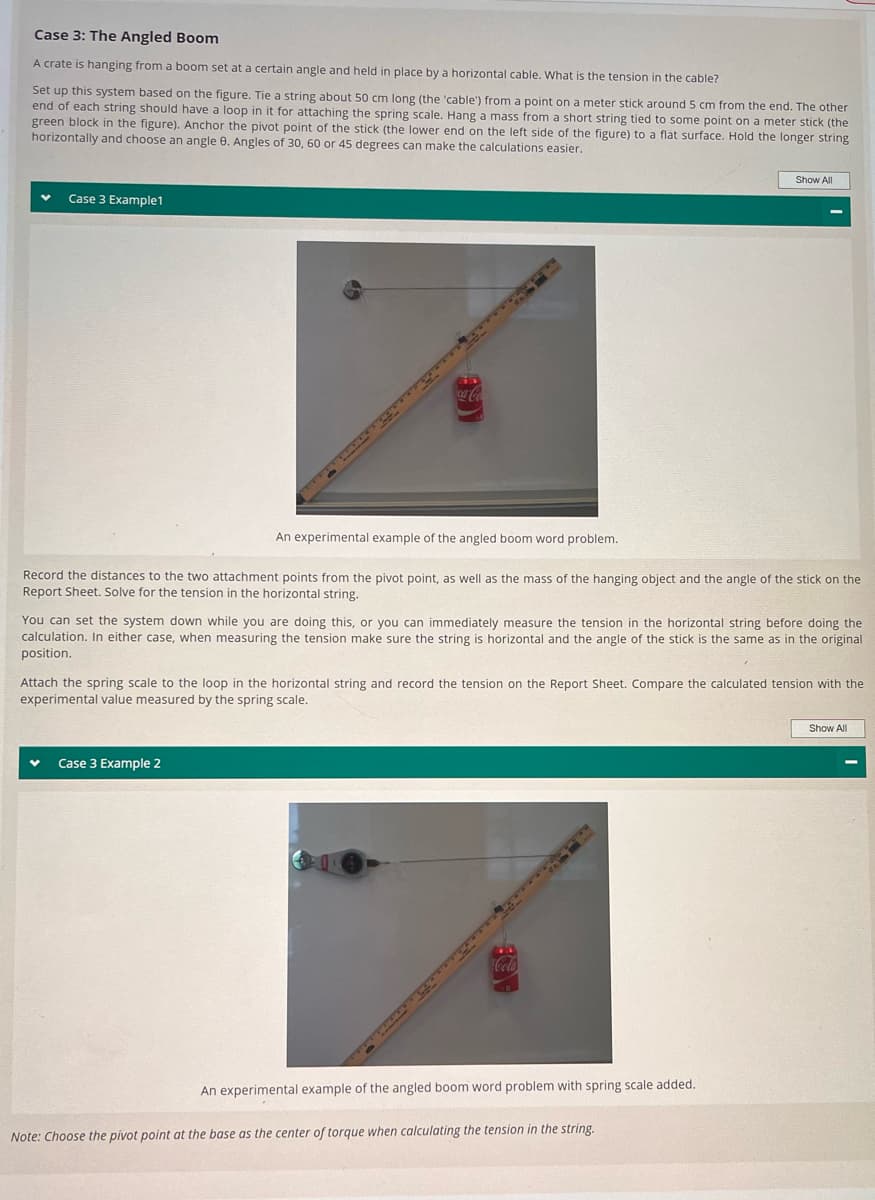Case three: the angled boom Weight of hanging object: 350g Location of hanging object: 63cm Angle of the boom: 30 degrees Weight of the stick: 100g Center of mass of the stick: 50 cm Location of string: 88cm Measured tension: 2N Please provide equations and calculations
Case three: the angled boom Weight of hanging object: 350g Location of hanging object: 63cm Angle of the boom: 30 degrees Weight of the stick: 100g Center of mass of the stick: 50 cm Location of string: 88cm Measured tension: 2N Please provide equations and calculations
Related questions
Question
Case three: the angled boom
Weight of hanging object: 350g
Location of hanging object: 63cm
Angle of the boom: 30 degrees
Weight of the stick: 100g
Center of mass of the stick: 50 cm
Location of string: 88cm
Measured tension: 2N
Please provide equations and calculations

Transcribed Image Text:The three conditions of static equilibrium are:
Lesson 12 Lab: Static Equilibrium
●
●
Introduction
●
Materials
In words, the sum of all the forces acting in the x-direction is zero; the sum of all the forces acting in the y-direction is zero;
and the sum of all the torques is zero.
Introduction
In this experiment, we will verify the static equilibrium conditions by re-creating three static equilibrium word problems. The
choice of force magnitudes, points of application and angles will be a matter of personal choice. The goal is to calculate all
forces for each system and compare the results to measured values.
Data Collection...
Statics Report Sheet (Download and print)
A meter stick or yardstick
A 5.0 N spring scale
Case 1 Example 1
ΣF = 0
ΣF, = 0
ΣΤ = 0
● String
Three objects with masses between 100-500 grams
A ruler and protractor
Conclusions
Materials
Data Collection and Analysis
Case 1: Traffic Light
A traffic light is hanging from two wires set at known angles. What is the magnitude of the tension in each wire?
Set up this system based on the figure. Hang an object of known mass from the center of a meter-long string with
loops on both ends for attaching the spring scale. It may be easier to tie a second shorter string to the center of the
first string and tie the object to the short string. Hold the long string in such a way that two different angles, 0₁ and 0₂,
are formed. It may be helpful to have an assistant, or tie one end of the string to a fixed object.
Show All

Transcribed Image Text:Case 3: The Angled Boom
A crate is hanging from a boom set at a certain angle and held in place by a horizontal cable. What is the tension in the cable?
Set up this system based on the figure. Tie a string about 50 cm long (the 'cable') from a point on a meter stick around 5 cm from the end. The other
end of each string should have a loop in it for attaching the spring scale. Hang a mass from a short string tied to some point on a meter stick (the
green block in the figure). Anchor the pivot point of the stick (the lower end on the left side of the figure) to a flat surface. Hold the longer string
horizontally and choose an angle 8. Angles of 30, 60 or 45 degrees can make the calculations easier.
Case 3 Example1
ca-Co
An experimental example of the angled boom word problem.
Record the distances to the two attachment points from the pivot point, as well as the mass of the hanging object and the angle of the stick on the
Report Sheet. Solve for the tension in the horizontal string.
Case 3 Example 2
You can set the system down while you are doing this, or you can immediately measure the tension in the horizontal string before doing the
calculation. In either case, when measuring the tension make sure the string is horizontal and the angle of the stick is the same as in the original
position.
Show All
Attach the spring scale to the loop in the horizontal string and record the tension on the Report Sheet. Compare the calculated tension with the
experimental value measured by the spring scale.
An experimental example of the angled boom word problem with spring scale added.
Note: Choose the pivot point at the base as the center of torque when calculating the tension in the string.
Show All
Expert Solution
This question has been solved!
Explore an expertly crafted, step-by-step solution for a thorough understanding of key concepts.
Step by step
Solved in 3 steps with 2 images
